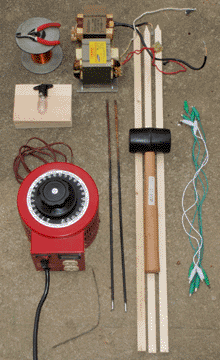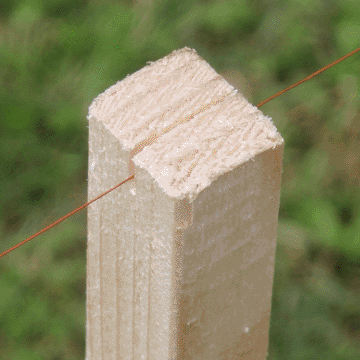
Old microwaves are full of useful parts. One of the most useful is the high voltage transformer used for powering the magnetron. These step up ordinary wall voltage (120VAC) to around 2000-3000VAC, with significant current capacity. For most projects, the secondary winding is removed and replaced with a lower voltage winding that is suitable for the task at hand. In this case, however, I used two intact transformers to make a miniature power transmission line.
The circuit is very simple. One transformer steps up the voltage from the wall, and the other steps it back down to power a small light bulb (also from a microwave). The two transformers are connected via a 20ft length of 32AWG copper wire, strung across posts. The return path is the earth itself, connected via steel grounding rods. Pictures of the parts used, the completed line, and an individual post can be seen below. The variac was used for safety purposes, to slowly ramp up the voltage supplied to the step-up transformer.



The setup worked very well, and the light bulb was equally bright whether it was connected over the transmission line or directly to the wall outlet. The output voltage of the step-down transformer was fairly stable as well, dropping less than a volt when the light bulb was connected. The only issue was that the step-up transformer got slightly warm. This was most likely due to the fact that I had to run it at slightly higher than its rated voltage, due to the two transformers being mismatched. The step-down transformer (pictured below) stayed cool throughout the entire experiment.

Interestingly, the grounding rods had the side effect of shocking any earthworms within a 12 inch radius, and within a few minutes at least 5 of them had crawled out of the ground. I felt bad for them, so I turned the power off and dismantled the transmission line.

While this particular implementation wasn't useful, such a circuit could be (and often is) used to supply power to remote areas, at low cost due to only requiring one fairly thin conductor. My implementation shows that microwave transformers can be used to this end, at least for small loads and short distances. One word of caution, however, is that the suspended power line is at several kilovolts relative to the ground, so under no circumstances should it be touched while in operation; microwave transformers can easily output a lethal amount of current. A more permanent installation of such a circuit should obviously have much taller posts, as well as some sort of insulator on top so that the post doesn't short the wire to ground when wet.